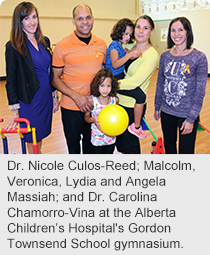
September 23, 2014
Story by Greg Harris; Photo by Paul Rotzinger
When she was seven months old, Lydia Massiah began treatment for a brain tumour that included neurosurgery and chemotherapy.
Hers was a long road to recovery but, today, Lydia is six years old. Her parents are grateful for the medical care she received but they say an important component of Lydia’s recovery has been an exercise program aimed at kids with cancer that she has taken part in.
“Getting our daughter involved in a regular program of physical activity has really helped build her strength and endurance, and it’s been something she’s had fun doing,” says mom Angela Massiah.
Now, parents of children with cancer have a new tool to safely introduce their sick kids to a program of physical activity tailored to their abilities.
The Pediatric Oncology Exercise Manual (POEM) equips parents with the knowledge to help kids better handle the side effects of treatment, increase their energy, and improve overall well-being.
“It’s been well-established that movement and exercise are very beneficial for this patient population but, until now, that knowledge has been in the hands of a relatively small number of specialists,” says Carolina Chamorro-Viña, PhD, a post-doctoral fellow who co-ordinated the development of POEM and is one of its editors.
“Our hope is that POEM will empower parents and their children to use physical activity as a fun and effective way to improve recovery, fitness and quality of life.”
Dr. Chamorro-Viña’s post-doctoral fellowship was funded by the Pediatric Oncology and Blood Marrow Transplant Program at Alberta Children’s Hospital.
Believed to be the first manual of its kind, POEM draws on the expertise of almost 25 health care professionals from around the world. It includes chapters on physical activity that take into account different types of cancers, such as leukemia and solid tumours, as well as different types of treatment side effects, such as damage to the heart muscle, osteoporosis, and graft-versus-host disease, which can result after a bone marrow or stem-cell transplant.
“Cancer treatments often lead to decreases in muscle mass, aerobic capacity and bone density, which can be countered with a program of physical activity,” Dr. Chamorro-Viña says.
POEM also has a companion manual aimed at health and fitness professionals. Development of the manuals was supported by a grant from the Canadian Institutes of Health Research.
“All kids need to move but, for kids with cancer, physical activity is even more important,” says Nicole Culos-Reed, PhD, a researcher with the Psychosocial Resources Department at Tom Baker Cancer Centre, an associate professor in the Faculty of Kinesiology at the University of Calgary, and one of the co-editors of POEM.
“Childhood cancer survivors are often at a higher risk for obesity. And because of their illnesses, they’ve been removed from their usual sports activities. Aside from promoting healthy development, getting them moving again also helps with their confidence, self-esteem and is an important component of their mental well-being.”
Lydia and her twin sister, Veronica, have for several years participated in the PEER program – Pediatric cancer patients and survivors Engaging in Exercise for Recovery – which was created by Drs. Chamorro-Viña and Culos-Reed at the U of C, and is delivered in partnership with Kids Cancer Care at Alberta Children’s Hospital.
“PEER has provided us with a physical activity program that’s tailored to Lydia’s abilities and needs,” says Malcolm Massiah, Lydia’s dad. “It’s something unique in the city – it’s a safe environment for kids to try things out and take a break from cancer. They can be kids again.”
For more information about POEM, or to obtain a copy, contact Dr. Culos-Reed’s lab at wellnesslab@ucalgary.ca.